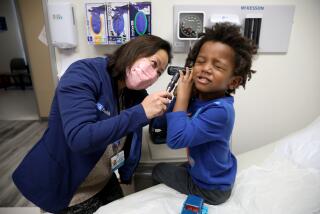Covered California enrolls nearly 1 million in health plans
California is nearing 1 million people enrolled in Obamacare coverage, but the state’s insurance exchange is still running behind in signing up Latinos and young people.
In figures released Thursday, the state said 923,832 people had picked a health plan through March 9, and about 1.5 million people have enrolled or been deemed eligible for an expansion of Medi-Cal, the state’s Medicaid program for the poor.
But the overall rate of health plan sign-ups slowed during February, partly hurt by a five-day outage of the state’s enrollment website. About 165,000 people enrolled in private health plans through the Covered California exchange last month, down from about 220,000 in January and 400,000 in December.
Exchange officials said they expect consumer interest to jump in the next two weeks as the March 31 enrollment deadline approaches.
The pace of enrollment “is slowing,” said Peter Lee, executive director of Covered California. “But we know these numbers will rise as we get closer to the deadline.”
The Obama administration is counting on California to deliver a final surge of enrollment to help compensate for an uneven rollout nationwide for the Affordable Care Act.
To spread the word, the state exchange has launched new ad campaigns in English and Spanish as part of its $80-million marketing budget. More than 600 enrollment events are planned in the next two weeks at libraries, schools and churches.
The exchange is urging people not to wait until the last minute to enroll. In late December, Covered California and health insurers struggled to handle an influx of applicants wanting coverage for Jan. 1. Many of the people signing up then were losing existing policies that didn’t comply with new requirements of the health law.
“Even with infinite resources, you can’t fit everyone in the pipeline if they wait until the last day,” Lee said. “I anticipate the last weekend will be pretty crazy.”
Customer service has been a nagging problem for the state. The average wait time for exchange callers was 47 minutes at the end of February. Lee said the addition of about 300 call-center employees has helped cut hold times to about 30 minutes.
“It’s not what we want, but the demand is incredibly strong,” Lee said.
Sheila Kern of West Los Angeles has run into numerous obstacles trying to get coverage. First, she was thwarted by the website problem last month. Then she booked an appointment with an enrollment counselor listed on the state website. But no one at a Santa Monica clinic was able to see her when she showed up.
Kern said she called the exchange last weekend to apply by phone but got disconnected twice. “The system is broken and it’s beyond repair,” she said.
Covered California said 22% of health plan enrollees through February described themselves as Latino on their application. That percentage was virtually unchanged from January results. Statewide, about 1.2 million, or 46%, of the 2.6 million Californians eligible for federal premium subsidies under the healthcare law are Latino.
Some members of Congress and state lawmakers have faulted Covered California for poor outreach to Latinos, who represent about 60% of the state’s uninsured. They have cited a shortage of enrollment counselors, boring ads and the absence of a paper application in Spanish until late December.
Supporters of the healthcare law worry that missing out on this relatively young and healthy population could undermine the viability of the exchange.
The turnout among young people ages 18 to 34 was up just slightly to 26.5% of total enrollment through February. That age group represents 36% of the people eligible for subsidies.
Persuading young, uninsured people to get health coverage remains a tough task.
Los Angeles college student Jade Moreno, 21, had seen ads for Covered California, but she assumed health insurance would be out of reach for her financially.
But when Moreno stopped by a clinic in downtown L.A. last month she discovered she qualified for Medi-Cal. “I didn’t realize it was free,” she said. “I didn’t want to end up paying for anything.”
Most Americans must have health insurance or face a tax penalty this year of $95 per adult or 1% of their household income, whichever is greater. The penalties rise in future years.
Lee said California still doesn’t have data on how many enrollees were previously uninsured. A key goal of the healthcare overhaul is to get coverage for uninsured people.
Thus far, health insurers said, about 85% of customers have paid their first month’s premium, ensuring that coverage takes effect.
Saturday is a key date for some consumers. March 15 is the cut-off for coverage that starts April 1. People can wait to sign up March 31, but their policy won’t kick in until May 1.
Twitter: @chadterhune
soumya.karlamangla@latimes.com
Twitter: @skarlamangla








